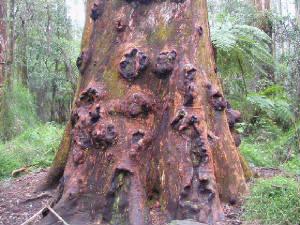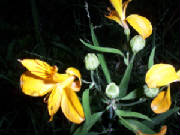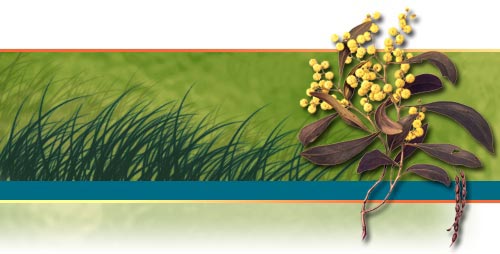|
The Dreaded Holly
A Short Course in weeding from
The University of Bitter Experience
Sherbrooke Forest Campus
Manual weeding is preferred and it is indeed the method most commonly used by the Friends of Sherbrooke. Any plant material
that is likely to layer if placed on the ground is either hung up in trees, placed on an improvised platform or taken out
of the forest in bags.
The spray technique is not used by the Friends group. However, Parks Victoria employ contractors to spray blackberry and
ivy as well as other exotic plants.
Trees, eg holly, sweet pittosporum and sycamore maple are drilled and filled with a suitable herbicide, as are the larger
trunks of ivy and cestrum. Drill holes are generally 8 or 10mm diameter and 15-25mm deep. In trees they are placed at 50-75mm
intervals around the base of the trunk or directly in the roots if these can be seen.
Sounds easy enough doesn`t it? Well, there are specific instructions on how to deal with Holly, just as an example to
show what really needs to be done to get rid of the nasty weeds. It has been written by Viv Freshwater (in the FOSF Newsletter
No 105)and nobody knows better than she does how to kill `em stone dead...
HOW TO DEAL WITH THAT PRICKLY CUSTOMER - ILEX AQUIFOLIUM (HOLLY)
Members of FOSF have had to learn new techniques in recent years to deal with environmental weeds other than English Ivy
and Sweet Pittosporum. This article describes the best technique we have come up with to successfully control Holly infestations.
1 The first task is to remove all the non-layered lower branches from the main trunk just above head height. This is a
safety measure to protect your face and eyes. Holly leaves have extremely sharp points on them, so be extra careful when completing
the task. Always store all cut branches up off the ground to prevent them from taking root.
2 The next task is to remove all the layered branches from around the tree. Cut the branch from the main trunk and carefully
pull it away from the tree. If the soil is moist and friable most of the rooted layers will be easily removed, but sometimes
some of the roots will remain in the soil. These will also need to be removed. A pair of pliers or a mattock will make the
task easier. All the individual layers must be removed, including the roots.Make sure that you check for branches that run
along the ground, but are still attached to the main trunk. Always clear the leaf litter away from the trunk to ensure that
all branches have been severed and removed from the tree. Any layers that are too large to be removed by hand can be treated
as a separate tree later. Once again, store the cut branches up off the ground.
3 When all the layers have been removed, drill holes into the base of the tree about 4 cm apart and fill with full-strength
herbicide. The holes need to be at least 2 cm deep. Always complete the drill and fill at the same time, taking no longer
than 30 seconds to fill the hole with herbicide. Then treat any large layered trees using the same method. Use a 12 mm to
14 mm drill bit, depending on the diameter of the tree. The larger the tree the more herbicide will be required to ensure
success. Large trees can take up to 9 months to completely die. If the whole tree is not dead by 12 months, check for areas
of live bark around the trunk. It may be necessary to retreat these areas again. Holly can be a difficult weed to eliminate.
This method may seem an extremely tedious and time consuming way of dealing with this weed, but unfortunately the nature
of Holly is that if it is not treated correctly, that is, removing all the layered branches, it will regrow and your precious
volunteer time will have been wasted. A positive outcome of all this hard work is that the lyrebirds will have many new areas
in which to feed, as has been observed in the areas where this technique has been used in Sherbrooke Forest.
|



















